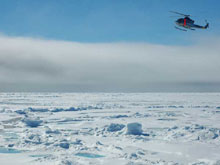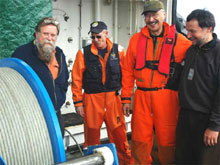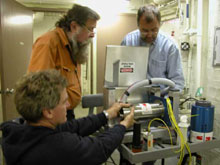
The North Slope Borough Department of Search and Rescue (NBSAR) helicopter approaches the HEALY over ice-covered waters. Click image for larger view and more details.
Help from the Outside
July 8, 2005
Kelley Elliott
Web Coordinator
NOAA Office of Ocean Exploration
Jeremy Potter
Expedition Coordinator
NOAA Office of Ocean Exploration
We are days from shore, on an icebreaker in the middle of the frozen, Arctic Ocean. More than 30 scientists are on board, divided into teams to study different portions of the Canada Basin. One of the key tools to seeing what lives in the deeper seas is the Remotely Operated Vehicle on board, used by scientists to study the deeper pelagic (open-water) and benthic (seafloor) realms. So what do you do when a part on an important instrument breaks? People on board the USCG Cutter HEALY had to face this problem when the slip-ring assembly on the ROV was seriously damaged, and the answer lay beyond the ship.
On July 2nd the ROV encountered a slight power-failure at 2000 meters when a kink in the line shut off just enough power for the High Definition camera, our eye into the sea, to lose power. Some slick maneuvering temporarily fixed the situation as skilled ROV pilots “untied the knot,” but it highlighted a larger problem. The Fiber Optic Rotary Joint (FORJ), a part of the ROV, had been seriously damaged. The FORJ used for the Deep-Sea Systems, Inc. (DSSI) ROV has 7 fiber channels to transfer information. Under normal conditions, one channel is needed for telemetry (communication with the ROV) and the normal video cameras. A second channel is used for the HD video signal. Of the 7 fibers, only one functioned properly, providing enough information for telemetry and video, but not the HD camera. We became increasingly concerned it would only be a matter of time before the single working fiber would fail as well. A new part was needed, but from where?
Chris Nicholson, President of DSSI, called the HEALY on July 4th with good news. After calling many companies, closed for the holiday weekend, he finally spoke with Snap Pearson, President of IEC Corporation. IEC had a replacement module available for shipment the following morning. Mr. Pearson even made shipping for the FORJ from Austin, Texas to Barrow, Alaska the top priority. While the piece was en route, IEC sent digital versions of the assembly instructions, procedures and drawings coming with the part to give the ROV operators a head start.

The Bell 412 NSBSAR helicopter has arrived! Pilots Chuck Bensow and Hugh Patkotak safely deliver a fiber optic rotary joint for the ROV on board. Click image for larger view.
Getting the part to Barrow, Alaska, however, would not be so easy. IEC sent the part from Austin, Texas to the University of Alaska, Fairbanks where it was to be picked up by Ruth Post early in on the evening of July 5. The part had to arrive before 6pm or Ruth would not be able to get it onboard the last of two daily flights from Fairbanks to Barrow, Alaska. After various delays with FedEx shipping between Texas and Fairbanks, delivery in Fairbanks shifted from July 5 at 5:30 PM to 11:30 PM to 1:30 AM on July 6, to 10:30 AM and finally to 1:30 PM.
Henry Gueco, the Barrow Arctic Science Consortium (BASC) Operations Manager, picked up the package after it arrived on the Alaska Airlines Goldstreak flight from Fairbanks that evening. The big question, how to get the part from Barrow to the ship, was still uncertain.
At more than 100 nautical miles from shore, the US Coast Guard Cutter HEALY lay out of flight range for HEALY helicopters. What to do next depended on whether a helicopter with a longer range was available. The North Slope Borough Department of Search and Rescue (NSBSAR) maintains a helicopter with a longer flight range than HEALY's helicopters- NSBSAR is the organization that answered the science party's request for assistance to transport the ROV to the HEALY on June 26th. Given NSBSAR's primary search and rescue responsibilities, they would likely be unable to fulfill the request. Nonetheless, Henry Gueco would request the assistance on behalf of the science party.
If NSBSAR were unable to assist, HEALY command and the science party would have to alter the cruise track to return within 100 nautical miles of Barrow where, weather permitting, a HEALY helicopter would fly to Barrow to pick up the part. This option would cost two valuable science days, or approximately an entire science station. For several hours, ship-to-shore communications difficulties prevented the science party from touching base with Henry regarding NSBSAR's answer. With the clock ticking the science party and HEALY command made preparations to turn-around and return to within 100nm of Barrow. Soon after preparations began, the science party successfully reached Henry. We were stunned when he told us that NSBSAR would actually be available to fly! LCDR Jim Daltisch, HEALY Operations Officer, took charge and coordinated the final flight of the parts whirlwind trip from Texas to the Arctic.

Dale Chayes and Chief Scientist Rolf Gradinger offer a warm welcome to NSBSAR pilots Chuck Bensow and Hugh Patkotak. After flying a needed ROV part from Barrow, Alaska to the USCGC HEALY in the Arctic Ocean, the pilots received lunch, fuel, a tour of the ship, and many rounds of thanks before beginning their return flight to Barrow. Click image for larger view.
Immediately after Chuck Bensow and Hugh Patkotak, NSBSAR pilots, landed the Bell 412 helicopter on the HEALY flight deck, the package was rushed to the ROV team to begin installation. The pilots received lunch, fuel, a tour of the ship, and many rounds of thanks before beginning the return flight to Barrow. The ROV is now deep down and operational!
Scientists crowd into a freezer that has been converted to the ROV control room, excitedly pointing out alien-like creatures and perhaps even new species flashing across the screen. Although they are in front of glowing monitors displaying ROV footage from the deep, the hero's behind the this moment are the people that contributed to getting the FORJ to the USCG Cutter HEALY 160 nautical miles out in an ice-covered sea. Thanks to everyone that helped!!
Sign up for the Ocean Explorer E-mail Update List.

































